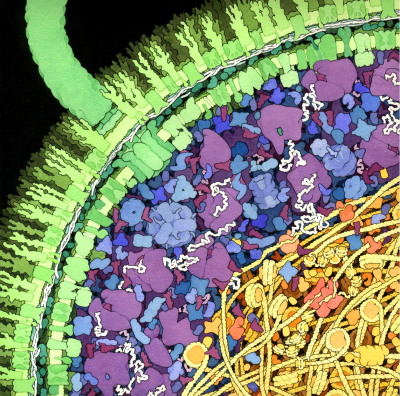Molecular Landscapes by David S. Goodsell
Escherichia coli, 1999
Acknowledgement: Illustration by David S. Goodsell, The Scripps Research Institute. doi: 10.2210/rcsb_pdb/goodsell-gallery-001
Please note: this early illustration is included in the gallery for historical reasons. We suggest that you use the more accurate, updated illustration of E. coli.
This illustration shows a cross-section of a small portion of an Escherichia coli cell. The cell wall, with two concentric membranes studded with transmembrane proteins, is shown in green. A large flagellar motor crosses the entire wall, turning the flagellum that extends upwards from the surface. The cytoplasmic area is colored blue and purple. The large purple molecules are ribosomes and the small, L-shaped maroon molecules are tRNA, and the white strands are mRNA. Enzymes are shown in blue. The nucleoid region is shown in yellow and orange, with the long DNA circle shown in yellow, wrapped around HU protein (bacterial nucleosomes). In the center of the nucleoid region shown here, you might find a replication fork, with DNA polymerase (in red-orange) replicating new DNA.




